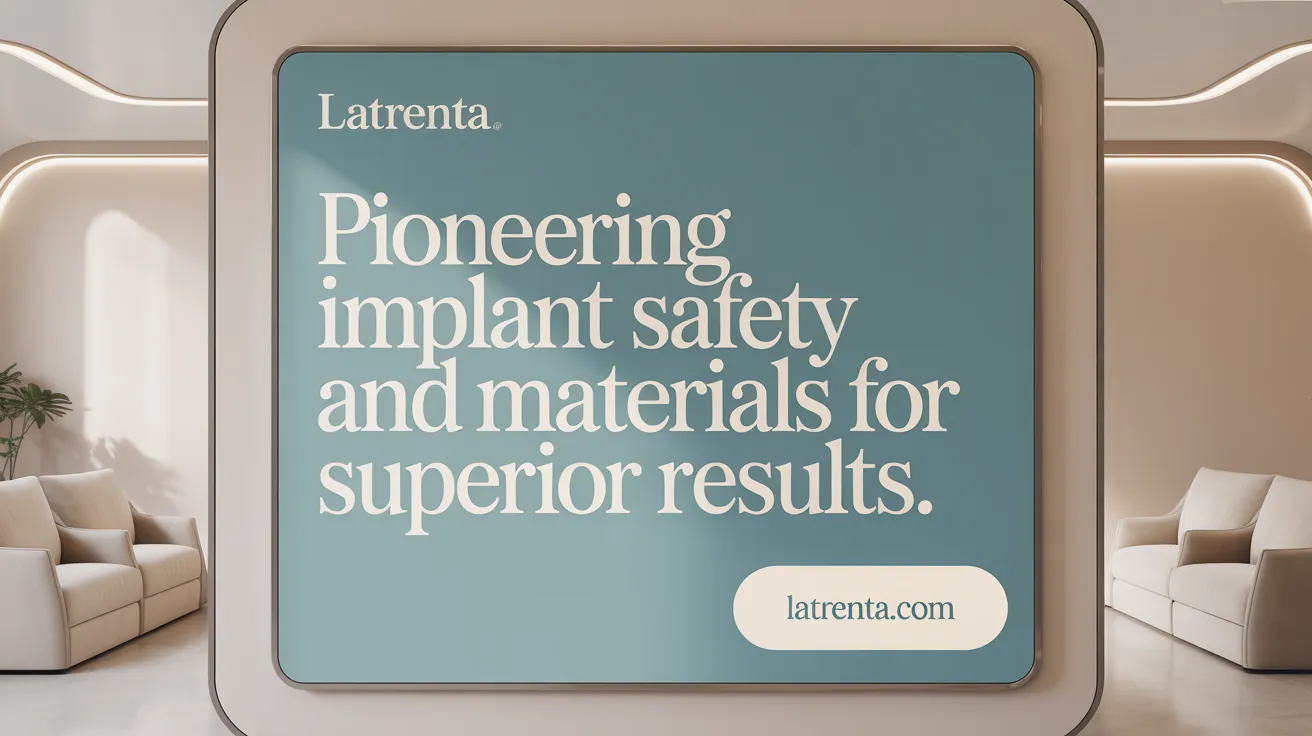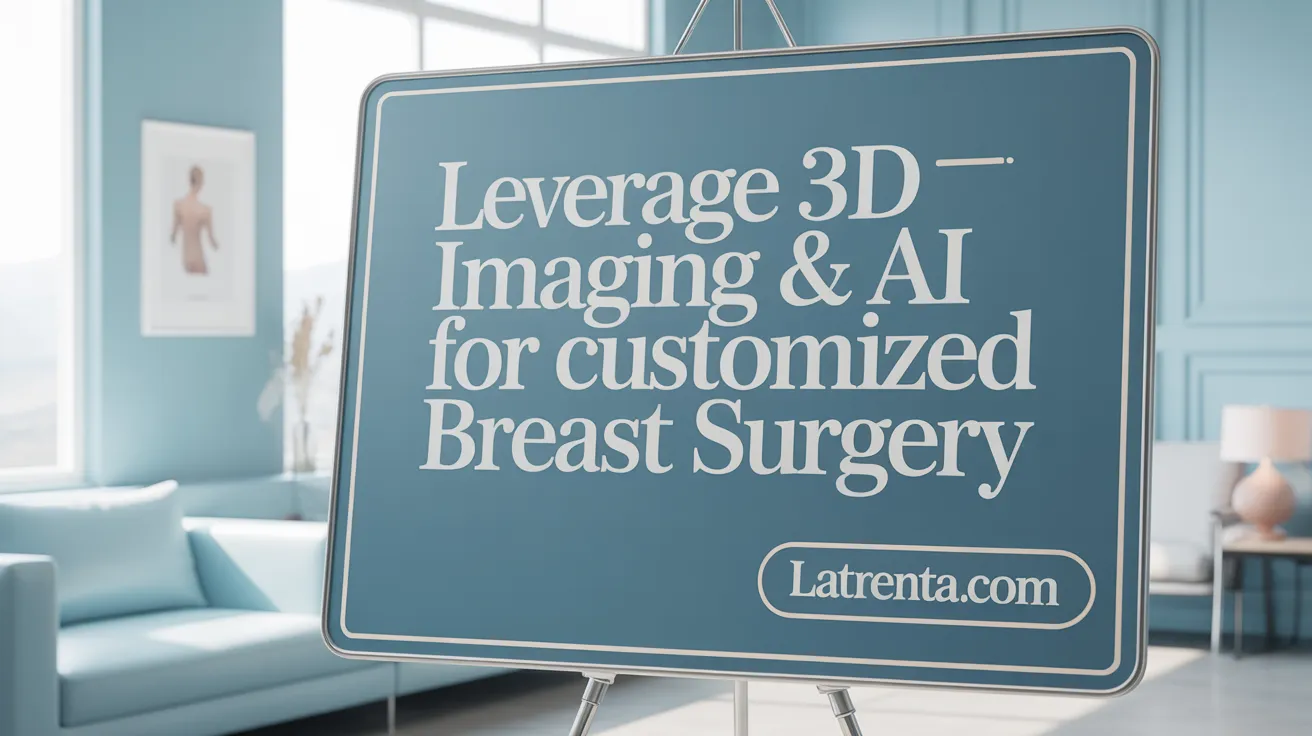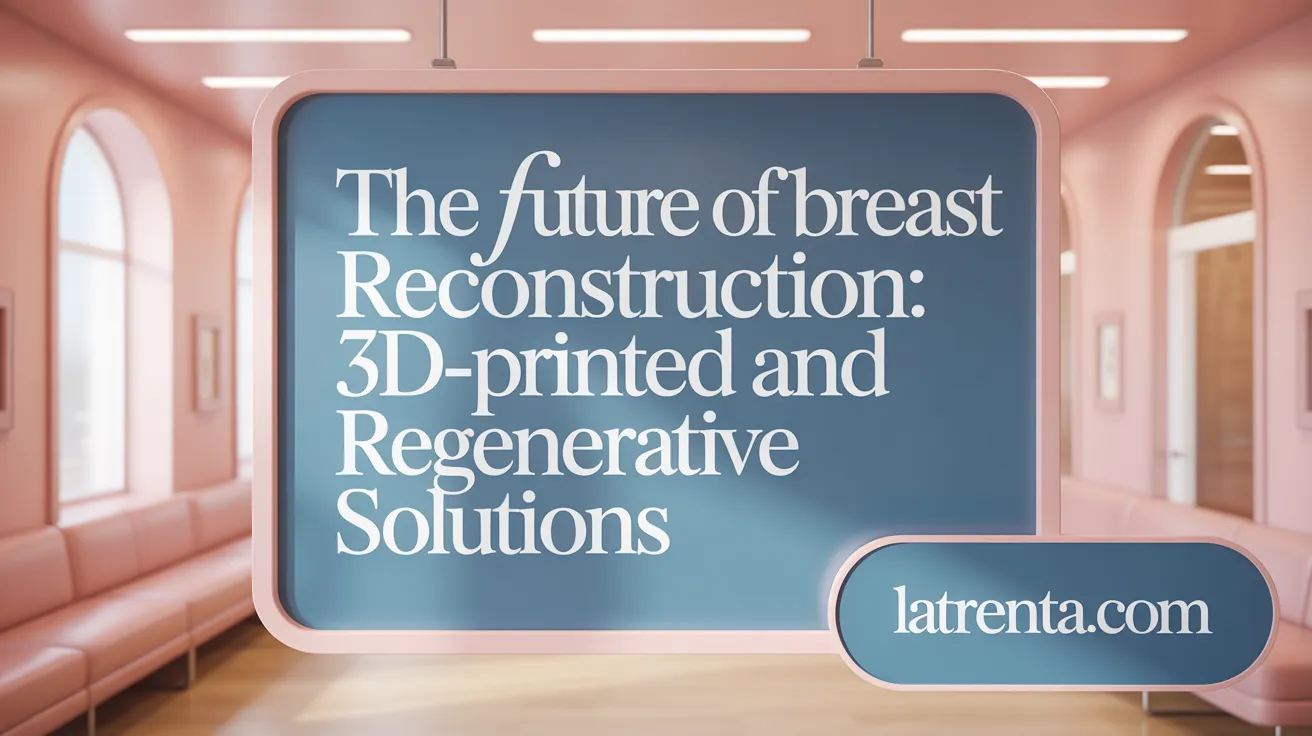Setting New Standards in Breast Enhancement
The landscape of breast aesthetic enhancements is rapidly evolving, integrating state-of-the-art implant technologies, innovative surgical techniques, and personalized planning tools. As patient demand shifts toward natural, athletic, and proportionate outcomes, the industry responds with safer materials, regenerative methods, and advanced digital aids that promise improved safety, recovery, and satisfaction. This article delves into the dynamic innovations shaping breast augmentation and reconstruction in 2025 and beyond, blending science and artistry to redefine aesthetic excellence.
Current and Emerging Trends Transforming Breast Aesthetic Enhancements
 In 2025, breast aesthetic enhancements continue to evolve with a strong focus on natural-looking results that seamlessly blend with each patient’s unique anatomy. Advances in surgical techniques and technology allow for highly personalized procedures, often involving sophisticated 3D imaging and AI-assisted planning that enable surgeons and patients to envision outcomes with precision. A notable innovation is the development of cohesive silicone gel implants, often referred to as "Gummy Bear" implants, now in their latest generations. These implants are known for their shape retention, durability, and biocompatibility, contributing to safer, more natural feels and appearances.
In 2025, breast aesthetic enhancements continue to evolve with a strong focus on natural-looking results that seamlessly blend with each patient’s unique anatomy. Advances in surgical techniques and technology allow for highly personalized procedures, often involving sophisticated 3D imaging and AI-assisted planning that enable surgeons and patients to envision outcomes with precision. A notable innovation is the development of cohesive silicone gel implants, often referred to as "Gummy Bear" implants, now in their latest generations. These implants are known for their shape retention, durability, and biocompatibility, contributing to safer, more natural feels and appearances.
A major trend is the increased utilization of fat transfer augmentation, which harvests fat from areas like the thighs or abdomen and injects it into the breasts. This method offers a subtle, natural enhancement and is often combined with traditional implant procedures in hybrid techniques, providing customized contours and softer transitions. Patients also favor minimally invasive surgeries that feature smaller incisions and less tissue disruption, leading to quicker recoveries and minimal scarring.
In addition to volume enhancement, there is significant progress in breast lifting and reduction procedures that minimize visible scarring while maintaining sensation and function. Innovative approaches such as the use of dissolvable scaffolds and advanced surgical devices support tissue preservation and faster healing.
Safety remains a top priority, with the incorporation of smart implants equipped with biosensors, improved implant materials resistant to rupture, and monitoring systems that help ensure long-term safety. Overall, the current trends promote personalized, safe, and aesthetically natural results that emphasize patient satisfaction and long-lasting outcomes.
For more in-depth details on these developments, searching "latest breast augmentation trends 2025" can provide extensive insights into the newest innovations shaping breast enhancement procedures.
Innovations in Implant Technology: Safety, Materials, and Design Enhancements
 Recent advancements in breast implant technology have significantly improved both safety and aesthetic outcomes. One major innovation is the use of highly cohesive silicone gels, often called Gummy Bear implants or ProgressiveGel, which retain their shape even if the implant shell ruptures. This reduces the risk of silicone leakage and enhances long-term reliability.
Recent advancements in breast implant technology have significantly improved both safety and aesthetic outcomes. One major innovation is the use of highly cohesive silicone gels, often called Gummy Bear implants or ProgressiveGel, which retain their shape even if the implant shell ruptures. This reduces the risk of silicone leakage and enhances long-term reliability.
Modern implants now feature ultra-thin, yet durable shells that improve flexibility, minimize rippling, and facilitate a more natural look and feel. These shells are often reinforced with barrier layers, such as BluSeal®, which help prevent rupture and silicone bleed.
Surface technology has also advanced with the introduction of micro- and nano-textured surfaces. These textures promote better tissue integration, implant stability, and lower the incidence of capsular contracture—a common complication that can cause firmness and distortion.
A breakthrough development is the introduction of the Motiva breast implants, which incorporate TrueTissue Technology. This technology enables the implant to mimic natural tissue movement—round when lying down and teardrop-shaped when upright—delivering more natural contours.
To enhance safety and tracking, innovative systems like Q Inside Safety Technology™ embed RFID micro-transponders within the implant. These allow for quick identification of implant details during surgeries or emergencies, improving monitoring and patient safety.
In addition, lightweight and highly customizable implants are now available, fitting individual anatomy and lifestyle needs better. The trend toward smaller, more natural, and shape-specific implants reduces complications and increases patient satisfaction.
Overall, these technological improvements aim to create safer, more reliable, and more aesthetically pleasing breast augmentation options for patients worldwide.
For further exploration into these advancements, searching 2025 breast implant technology innovations provides current and detailed information on the field's rapid progress.
Evolving Surgical Techniques and Regenerative Approaches Redefining Augmentation

What are the minimally invasive, regenerative, and innovative approaches currently being explored in breast aesthetics?
In 2025, breast augmentation is experiencing a revolution with techniques that focus on minimal tissue disruption, faster recovery, and more natural results. One prominent method is the Preservé™ technique, which employs advanced Motiva® technology. This approach involves creating a precisely formed implant pocket using inflatable balloons, allowing for smaller incisions and less trauma during surgery. The result is reduced scarring and quicker return to everyday activities.
Regenerative strategies are increasingly integrated within aesthetic procedures. Utilizing stem cells derived from the patient's own adipose tissue, these techniques promote natural tissue growth and healing, minimizing reliance on synthetic implants. Growth factors and bioengineered scaffolds are also under exploration, aiming to enhance tissue quality and resilience. For more details on stem cell breast augmentation and regenerative medicine and bioengineered breast scaffolds, see these sources.
Innovations extend to the implants themselves as well. Modern options such as Motiva® SmoothSilk Ergonomix® implants mimic natural breast tissue, adapting dynamically to body movement and providing a more lifelike feel. These biologically inspired materials improve aesthetic coherence and long-term stability. Learn more about advanced breast implant technologies including gummy bear implants and cohesive gel silicone implants.
Hybrid procedures are gaining popularity, combining traditional implants with fat grafting or regenerative techniques. Such integration allows for personalized outcomes that emphasize softness, natural contours, and function. Explore hybrid breast augmentation procedures and fat transfer in breast augmentation.
Additional minimally invasive procedures include endoscopic implant placement, which uses tiny cameras and instruments through small incisions, and threadlifting or scarless breast lifts that utilize dissolvable threads for lifting and reshaping without open surgery. These are covered under advanced minimally invasive breast enhancement techniques.
Furthermore, the use of biologics and regenerative medicine, such as fat stem cell augmentation, aims to foster natural tissue regeneration, reducing complication risks and improving overall tissue health, as discussed in sources about fat grafting and stem cell breast augmentation.
In summary, these advancements exemplify a shift towards safer, more natural, and sustainable breast aesthetic surgeries, with an emphasis on preservation of function and aesthetics, all facilitated by cutting-edge biotech and surgical innovations such as Preservé™ technology, Motiva implants, and 3D imaging with AI-assisted surgical planning.
Personalized Planning and Digital Innovations Enhancing Surgical Precision and Patient Satisfaction

How are advanced planning tools and personalized surgical approaches implemented to achieve aesthetic goals in breast surgery?
Modern breast surgery increasingly relies on sophisticated digital tools that enable highly customized procedures. Technologies such as 3D imaging and simulation software allow surgeons to visualize potential outcomes before the operation, helping both the surgical team and the patient align on expected results. These tools analyze individual breast anatomy, skin quality, and tissue characteristics to tailor implant size, shape, and placement.
In addition to imaging, detailed radiological evaluations guide precise surgical planning, ensuring safety and aesthetic harmony. A multidisciplinary approach enriches the process, involving radiologists, oncoplastic specialists, pathologists, and mental health professionals, aiming both for oncological safety and optimal aesthetic results.
Intraoperative imaging techniques, such as indocyanine green (ICG) angiography, are utilized to assess tissue vascularization in real-time. This helps determine the best reconstructive method, especially when placing implants above or below the muscle, reducing risks of tissue necrosis and enhancing healing. These advances align with innovative breast surgery techniques that improve surgical accuracy and outcomes.
Virtual reality consultations are emerging as a way to help patients preview their post-surgical appearance vividly, increasing confidence and satisfaction. Postoperative protocols are also individualized, encompassing tailored recovery plans, aesthetic refinement procedures, and psychological support to optimize long-term outcomes.
Overall, these innovations foster highly personalized surgical approaches that respect each patient’s unique anatomy and aesthetic desires. This precision results in improved surgical accuracy, fewer complications, and higher patient satisfaction, contributing to better quality of life after breast surgery.
For further information, search: "3D imaging surgical breast augmentation planning".
Future Horizons: 3D-Printed Tissue Implants and Regenerative Medicine Breakthroughs
 The future of breast reconstruction is poised for remarkable innovation, with advanced 3D-printed personalized implants techniques leading the way. Researchers are exploring ways to create functional, biocompatible breast tissue through the use of patient-specific scaffolds that are seeded with stem cells derived from adipose tissue. These bio-printed structures aim to mimic natural breast tissue more accurately than traditional implants, offering durable and personalized solutions.
The future of breast reconstruction is poised for remarkable innovation, with advanced 3D-printed personalized implants techniques leading the way. Researchers are exploring ways to create functional, biocompatible breast tissue through the use of patient-specific scaffolds that are seeded with stem cells derived from adipose tissue. These bio-printed structures aim to mimic natural breast tissue more accurately than traditional implants, offering durable and personalized solutions.
Progress in bio-ink materials—including hydrogels, natural polymers, and other natural substances—is crucial for supporting tissue growth and integration. These materials are designed to enhance cell adherence, promote vascularization, and reduce the risk of resorption, a common challenge in tissue engineering.
Innovations are also integrating advanced imaging technologies like MRI and AI-driven simulation tools. These enable surgeons to precisely plan and customize procedures, visualizing how the reconstructed tissue will look and function before surgery. This integration improves aesthetic outcomes and ensures a better fit with the patient’s body.
One of the most promising developments is the potential to eliminate foreign materials altogether. By using biodegradable scaffolds created through 3D printing, surgeons can reduce risks associated with traditional foreign objects, such as capsular contracture or implant rupture. These scaffolds can be custom-designed to match the patient’s anatomy, and they degrade over time, leaving behind only the patient’s own regenerated tissue.
Furthermore, advances in regenerative medicine and smart biomaterials—including bio-inks that adapt and support tissue growth—are set to revolutionize the field. In-office 3D printing of personalized implants could become a reality, significantly reducing costs and wait times. Clinical trials are ongoing, and early results suggest these techniques will provide more natural, durable, and tailored reconstruction options.
Overall, the combination of regenerative science, customized biofabrication, and intelligent imaging promises a new era in breast reconstruction where “foreign” implants may be replaced by living tissue, fundamentally transforming patient care.
The Future of Breast Aesthetic Enhancements
Innovations in breast aesthetic enhancements are revolutionizing how surgeons and patients approach augmentation and reconstruction. Groundbreaking implant technologies, regenerative methods, and minimally invasive techniques foster natural, safe, and personalized results tailored to individual needs. The integration of digital planning tools and multidisciplinary care models enhances precision and patient satisfaction, while emerging breakthroughs in 3D bioprinting and stem cell therapies promise to redefine possibilities in tissue regeneration and reconstruction. As science and artistry converge, the future holds unprecedented opportunities for achieving aesthetic excellence with long-lasting, harmonious outcomes that prioritize patient safety and quality of life.
